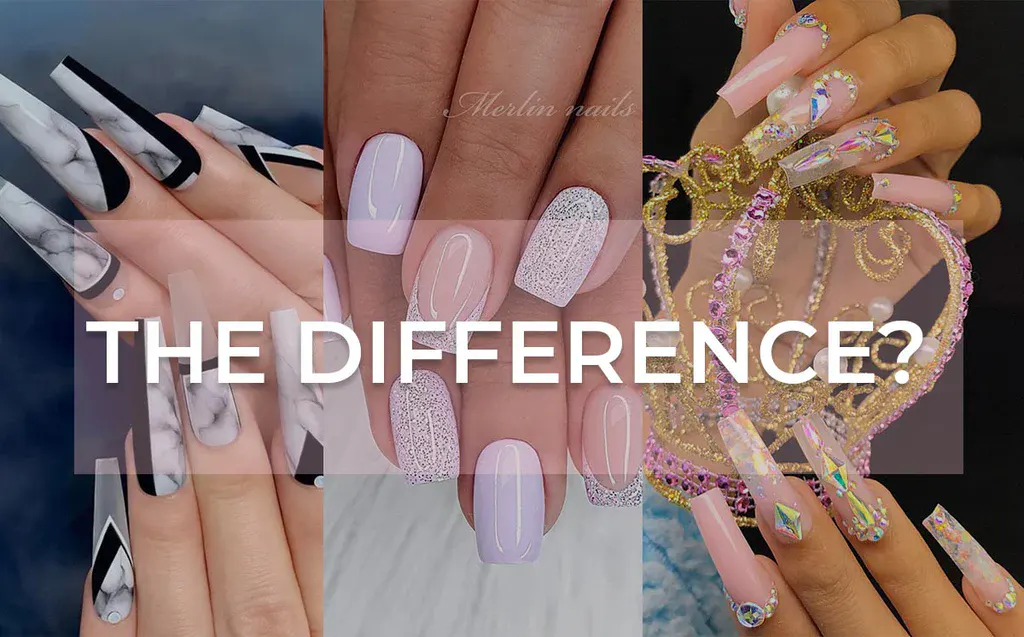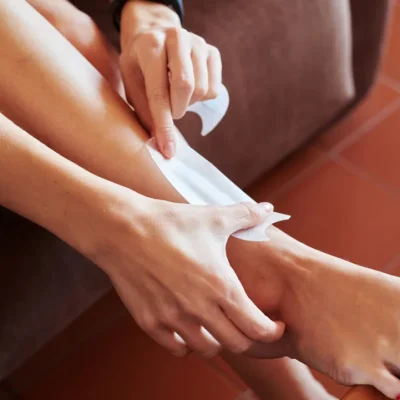Nail enhancements have evolved over the years, providing individuals with various options to achieve beautiful, long-lasting nails. Among the most popular choices are gel and acrylic nails. Both offer unique benefits and can significantly enhance the appearance of natural nails, but they differ in application, durability, removal process, and overall look and feel. Understanding these differences is crucial for anyone considering which type of nail enhancement to choose. In this blog post, Diva Salon helps provide an in-depth comparison between gel and acrylic nails, exploring their characteristics, pros and cons, and how to maintain them.
What Are Gel Nails?

Gel nails are a type of nail enhancement made from a gel-like substance that hardens under UV or LED light. This gel is applied in layers, starting with a base coat, followed by the gel polish, and finished with a top coat. Each layer is cured under the light to harden and set the gel.
The primary advantage of gel nails is their natural appearance and flexibility. They tend to be thinner and more flexible than acrylic nails, giving them a more natural look and feel. Gel nails are also known for their glossy finish, which can last for weeks without chipping or peeling.
The Application Process of Gel Nails
The application process for gel nails begins with preparing the natural nails. This involves cleaning, filing, and buffing the nails to create a smooth surface. A primer is applied to help the gel adhere better. The base coat of the gel is then applied and cured under a UV or LED light. Next, the gel polish is applied in layers, with each layer being cured under the light. Finally, a top coat is applied and cured to seal the polish and add shine.
One of the key benefits of gel nails is the curing process. Unlike traditional nail polish, which can take a long time to dry and is prone to smudging, each layer of gel polish hardens completely under the light, allowing for a smudge-free finish.
The application process of gel nails involves several key steps to achieve a long-lasting, glossy finish. First, the natural nails are cleaned and shaped. A base coat is applied and cured under a UV or LED lamp. Next, a colored gel polish is applied in thin layers, with each layer cured before the next is added. Finally, a top coat is applied and cured to seal the design. This process ensures durability and a high-shine finish, making it a popular choice for nail services.
What Are Acrylic Nails?
Acrylic nails are another popular form of nail enhancement, known for their durability and strength. They are made by combining a liquid monomer and a powder polymer to form a paste, which is then applied to the natural nails and shaped as desired. The acrylic hardens when exposed to air, creating a strong, durable layer over the natural nails.
Acrylic nails are often chosen for their strength and versatility. They can be easily shaped and lengthened, making them ideal for those with weak or brittle nails. They can also be customized with various designs and colors, offering a wide range of aesthetic options.
The Application Process of Acrylic Nails
The application process for acrylic nails starts with preparing the natural nails, similar to gel nails. The nails are cleaned, filed, and buffed to create a smooth surface. A primer is applied to ensure the acrylic adheres properly. The liquid monomer and powder polymer are then mixed to form a paste, which is applied to the nails using a brush. The acrylic is shaped as desired and allowed to harden in the air.
Once the acrylic has hardened, the nails are filed and buffed to smooth out any rough edges and create the desired shape. Finally, a top coat is applied to add shine and protect the acrylic.
Durability and Maintenance
Both gel and acrylic nails are known for their durability, but they differ in how they withstand wear and tear. Gel nails are more flexible, which makes them less prone to cracking and breaking. However, they can still lift at the edges over time, especially if not applied correctly or if exposed to harsh conditions.
Acrylic nails, on the other hand, are harder and more rigid. This makes them extremely durable and resistant to damage, but also more prone to cracking if subjected to heavy impact. They are also more likely to cause damage to the natural nails if not maintained properly.
Removal Process
The removal process for gel and acrylic nails is another area where they differ significantly. Gel nails are typically soaked off using acetone. This involves wrapping the nails in acetone-soaked cotton balls and aluminum foil for about 10-15 minutes. The gel softens and can be gently pushed off with an orange stick or cuticle pusher. This process is relatively gentle on the natural nails, provided it is done correctly.
The removal process involves carefully extracting unwanted items or materials from a space, ensuring minimal disruption and damage. It begins with assessing the items to be removed, planning the best approach, and using appropriate tools and techniques. Proper disposal or recycling follows to maintain environmental responsibility. Linking this with home services, a professional removal service ensures efficient and thorough handling of household clutter, old furniture, or renovation debris, streamlining the process and enhancing home organization and cleanliness.
Removing acrylic nails, on the other hand, is more challenging. They can be soaked off using acetone, but this process takes longer, usually around 30-40 minutes. Additionally, the hardened acrylic can be more difficult to remove and may require filing or buffing, which can damage the natural nails if not done carefully.
Aesthetic Differences
Aesthetically, gel and acrylic nails offer different finishes. Gel nails are known for their glossy, natural-looking finish. They are available in a wide range of colors and can be customized with various designs and patterns. The flexibility of gel nails also allows for a more natural look and feel.
Acrylic nails, while also customizable, tend to have a thicker, more artificial appearance. However, they offer greater versatility in terms of length and shape. Acrylic nails can be easily sculpted into various shapes and extended to any length, making them a popular choice for dramatic nail designs.
Aesthetic differences in home services, such as landscaping, painting, and remodeling, can significantly impact the visual appeal of a property. For example, choosing between traditional and modern landscaping styles or different paint finishes can create varied atmospheres and enhance curb appeal. Remodeling options like cabinetry designs or flooring materials can transform interior spaces, reflecting personal style and increasing home value. Consulting with professionals ensures that these aesthetic choices align with your vision and the overall design of your home, resulting in a cohesive and attractive environment.
Cost Comparison
The cost of gel and acrylic nails can vary depending on the salon and location, but there are general trends. Gel nails are often slightly more expensive due to the materials and equipment required, such as UV or LED lamps. The application process can also be more time-consuming, contributing to the higher cost.
Acrylic nails are generally more affordable, though the price can increase with additional customization, such as nail art or extensions. It’s also important to consider the cost of maintenance and removal, as both types of nails require regular upkeep to keep them looking their best.
Longevity and Durability
Gel nails typically last about two to three weeks before they start to show signs of wear, such as lifting at the edges or chipping. They can be maintained with regular fill-ins, but it’s important to give the natural nails a break periodically to avoid damage.
Acrylic nails are known for their durability and can last up to three to four weeks with proper maintenance. They are less prone to lifting and can withstand more wear and tear, making them a popular choice for those who need long-lasting nail enhancements.
Maintenance Tips
Proper maintenance is crucial for both gel and acrylic nails to keep them looking their best and to prevent damage to the natural nails. For gel nails, it’s essential to keep the nails moisturized and avoid exposing them to harsh chemicals or excessive water. Regular fill-ins are also necessary to maintain the appearance and prevent lifting.
Acrylic nails require similar maintenance, including regular fill-ins and moisturizing. It’s also important to avoid using the nails as tools, as this can cause them to crack or lift. Additionally, keeping the nails clean and dry can help prevent infections and other issues.
Environmental Impact
The environmental impact of gel and acrylic nails is another factor to consider. The chemicals used in both processes can be harmful to the environment if not disposed of properly. Additionally, the UV lamps used for curing gel nails consume energy and can contribute to environmental degradation.
Acrylic nails involve the use of plastic materials that can take a long time to break down, contributing to environmental pollution. Choosing salons that use environmentally friendly products and practices can help mitigate some of these impacts.
Choosing the Right Nail Enhancement
Choosing between gel and acrylic nails ultimately comes down to personal preference and individual needs. Those looking for a natural appearance and flexibility may prefer gel nails, while those seeking durability and versatility might opt for acrylic nails. It’s also important to consider factors such as cost, maintenance, and potential health and environmental impacts when making a decision.
Choosing the right nail enhancement depends on your lifestyle, preferences, and nail health. For durability and a natural look, gel nails are a great option, offering a glossy finish and longer wear. Acrylic nails are ideal for those seeking more strength and length but require regular maintenance. For a more flexible and breathable option, consider dip powder nails. Each type has its benefits, so evaluate your needs and consult with a professional to ensure the best choice for your nails. For more guidance, explore the types of nails that suit different needs best.
FAQs
Which is better for nails, gel or acrylic?
In general, acrylic is better for intricate or textured designs and is stronger than gel, but takes longer to apply and can be more damaging to the natural nails. On the other hand, gel is shinier and cures quicker than acrylic, but is more flexible so it doesn’t always provide the same amount of protection.
What lasts longer, acrylic or gel?
If you give them the right care and maintenance, acrylic nails can last longer than gel nails.
Is gel more expensive than acrylic?
In summary, acrylic nails tend to be less expensive than gel nails. Still, the cost can vary depending on location, salon, technician, nail art, length and shape of the nails, and the technician’s skill. Both types of nails require regular maintenance, and the costs can add up over time.
Are gel nails fake nails?
Acrylics and Gels are fake nails placed over your natural ones. Both can be made to match the shape of the nail, or to extend it. So, when you want longer nails, you are asking for either Acrylic or Gel extensions.
How to remove acrylic nails?
Pour 100 percent pure acetone into a tray or bowl and soak your nails in it for five minutes. With a metal cuticle pusher, gently push the polish off your nails, pushing from your cuticles downward. Redip your nails for five minutes, then gently push again. Repeat until your acrylics have completely soaked off.
Conclusion
Both gel and acrylic nails offer unique benefits and can enhance the appearance of natural nails. Understanding the differences in application, durability, removal, aesthetics, and maintenance can help individuals make an informed decision about which type of nail enhancement is right for them. Whether opting for the glossy, natural look of gel nails or the durable, customizable finish of acrylic nails, proper care and maintenance are essential to keeping nails healthy and beautiful.




